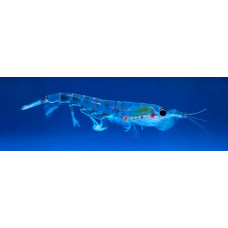Krill is a commercial name for small marine crustaceans that serve as food for whales, fish, seabirds, and others. Krill consists of black-eyed crustaceans (euphasiids), pelagic bocoplaves, and hyperiids. Krill is used to produce fodder meal, fat, and food paste.
Collective name for small marine planktonic crustaceans (crustaceans) of commercial size (10-65 mm) that form commercial aggregations in the surface water layers of the temperate and high latitude oceans of both hemispheres.
Pacific krill are represented by several major commercial species:
Euphausia pacifica, with a range extending in the North Pacific Ocean from Japan to the coast of southern California and the coast of Canada, is fished off Japan and British Columbia.
Euphausia nana, range - waters of southern Japan and the East China Sea, fished off Japan.
Nyctiphanes australis, inhabiting waters of southeastern Australia, Tasmania and New Zealand.
Several commercial species of the genus Thysanoessa are distributed in cold waters of the northern parts of the Atlantic and the Pacific Ocean:
Thysanoessa inermis - fished off the coast of Japan and in the Gulf of St. Lawrence.
Thysanoessa raschii - distributed in Arctic waters, fished in the Gulf of St. Lawrence, proposed as a species with commercial potential.
Meganyctiphanes norvegica, Norwegian krill, has the most extensive range in Atlantic waters of the northern hemisphere, from the subarctic waters of Greenland, Iceland and Norway to moderately warm waters from Cape Hatteras off the American coast in the west to the Mediterranean in the east. Fishing takes place mainly in the Gulf of St. Lawrence.
Krill
Tags: krill



